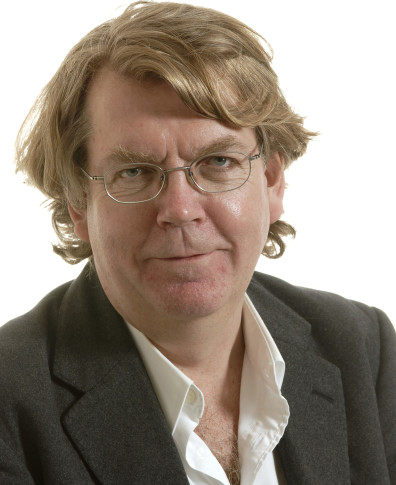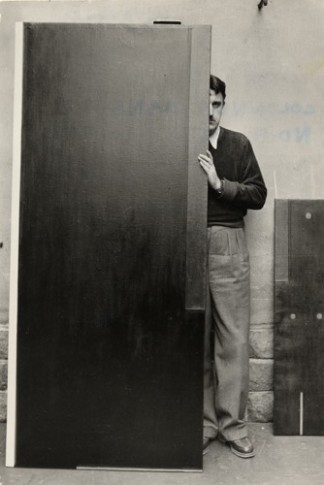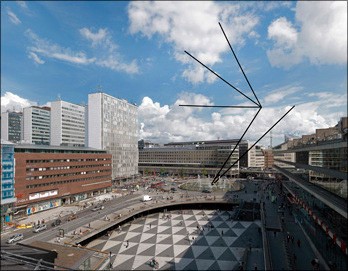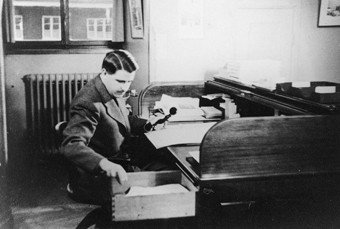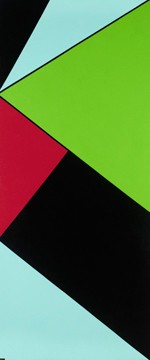
Olle Bærtling, Ra, 1954 © Olle Bærtling/BUS 2007
Contradictions Reconciled
During the 1940s, he devotes himself to figurative painting inspired by Henri Matisse. Immediately after the end of the Second Word War, he goes abroad, to Europe and arrives in London, where he paints the city’s ruins in an abstract style with a lot of black. His biographer Teddy Brunius writes: “During this period Bærtling’s painting contains cosmic themes. He was an admirer of science fiction, which could be seen at the cinema. He also picked up on industrial/mechanical themes. But the highly impulsive, brutal colour schemes – not so unlike the works of the Linien artists in Denmark, including Eiler Bille and Richard Mortensen –annoyed his colleagues in Swedish painting. It was not just that he was notoriously naïve. Evert Lundquist said, a tad disdainfully, “Ah, the banker.”(1)
Lundquist was alluding to the fact that Bærtling was, at that time, still working at the Skandinaviska Banken in Stockholm. Being a self-taught artist with a background specifically in banking was something that would haunt him for many years. The art world in Sweden, including Stockholm, was small, and if an artist had an epithet tagged onto him early on, it stuck. Especially if it came from influential, slightly more senior artists.
Despite the occasionally rather harsh reception of Bærtling’s work, he seems himself not to have been bothered by it. His periods of time off from his bank job gradually become longer. Then, in the mid-1950s, he stops working at the bank altogether, and instead starts making regular visits to Paris. There he comes into contact with the new concrete art, in particular through the Salon des Réalités Nouvelles, which was founded in 1946. He seeks out artists such as André Lothe and Fernand Léger, and also gets to know Victor Vasarely, Richard Mortensen and, first and foremost, Auguste Herbin. In his “essay in art criticism” Svensk konst efter 1945 (Swedish art after 1945) Olle Granath writes: “Bærtling’s acquaintance with Auguste Herbin showed him the way to the non-figurative painting to which he would soon give his personal stamp, with incomplete triangle-like shapes and a powerful, divergent use of colour. The incomplete triangles, what Bærtling himself called “open forms’, contribute to the way that we never experience any relationships in the paintings, such as that between foreground and background. Bærtling sees such relationships as ‘naturalism’. His main goal is to eliminate every possible reference to anything outside the picture itself. The picture’s expression has to be found exclusively in the tensions between colours and forms. The strips of black that separate the different colours are not the straight lines that they at first appear to be, but curves finely adjusted so as to compensate for the optical expansion or contraction produced by the various shades of colour. In this way, he builds up a picture that is tense to the point of excruciating, which excludes any sense of decoration.”(2)
Granath’s superb summing-up of Bærtling’s art is still the prevalent description. When, however, he increasingly frequently refines his triangular forms and approaches “open form” in the mid-1950s, deciphering them becomes more complex. The works do not refer to anything external, but to themselves – yet they still seem to point to something outside the picture space. The American minimalist Donald Judd, for instance, in a review of Bærtling’s exhibition at Columbia University in New York in Arts Magazine in 1964, proposes: “For example, the implication that a form continues beyond the painting is an old device by now, an easy way to suggest the continuation of something, either to a great extent or to infinity. It’s better than discrete and rationalistic parts, but it’s inferior to a more direct consideration of continuity and infinity, as in Frank Stella’s paintings.”(3)
Judd’s observation is thought-provoking. He thinks there is a certain parallel with American minimalism in Bærtling’s opening up of his forms. But, at the same time, Judd concludes his review with the words: “On the whole, Bærtling’s work is still too near the older geometric painting.”(4) By “the older geometric painting” Judd means the European tradition represented, for example, by De Stijl and the Russian constructivists: a utopian idealism. The development of abstract art goes in step with humankind’s liberation of itself from a deterministic cultural and social outlook around the beginning of the last century. Artists turned against the obsolete romantic viewpoint that saw the truth of art as being concealed in nature, and as something that could only be discovered by rare geniuses. In order to give visual form to this they chose not to depict nature, but to construct new aesthetic languages. But romanticism partially lived on. The goal, the utopia, of the new aesthetic reality was that humankind would be filled with a sublime energy and transform society.
It is interesting to compare this development with Bærtling’s own words. In “Prolog ur ett manifest till öppen form” (Prologue to a manifesto of open form) he writes: “It was clear to me that art should express humanity’s spiritual life, constructive creative energy, and capacity for imagination. Consequently all the naturalistic elements in art have to go.”(5) What does, however, distinguish him from the earlier pioneers of the beginning of the 20th century was that he seemed to have no desire to change society with his art. For instance, in an article in Arkitektur magazine he writes: “The creative artist is free and has to be free in his creative work. He has nothing to do with anything else, the social, the political, etc. On the whole, nothing to do with society and its compromises. He only has to do with the inner reality, the forces that direct everything, invisible, yet nonetheless humankind’s biggest source of energy and true reality, the prerequisite for all progress, the creator of the culture that we call our own.”(6)
But what, then, are he and his wife Lisa doing at a Mayday demonstration in 1961? The previously unpublished photograph shows the couple with a placard. Although not a placard with a political message, but one with a reproduction of a work of art: Pablo Picasso’s famous Guernica from 1937. Considering Bærtling’s reluctance to get involved in the social or political situation, it is odd that the couple went on a demonstration at all, and specifically with Guernica – the painting is, of course, a politically and socially critical broadside aimed at world fascism. The work had been shown in 1956 in the vacant drill hall at Skeppholmen in Stockholm, and was the opening shot for the Moderna Museet, which was inaugurated in the same building in 1958. Perhaps the choice of Guernica was specifically a symbolic act on behalf of the new future of art? Or is it, as his friend and colleague at the Skandinaviska Banken and subsequently author John Einar Åberg, writes in his posthumously published collection of poems Stenbrotten: dikter och dagboksblad (quarries: poems and pages from a diary)(7), that Bærtling was driven by a powerful passion for justice?
Bærtling
Harsh colours
angry glances
suspicious
behind it
a tender
vibrant emotion
hatred
of falsity
and bullying
a striving
for purity of spirit
Åberg’s interpretation of Olle Bærtling the person and the artist hits the nail on the head. Especially Bærtling’s dichotomous, occasionally contradictory sides. On the one side, we glimpse a visionary: “The art of the open form can be compared to the unknown forces and extent of the heavens, of infinite space. It is split light in infinite spaces in a powerful dynamic. The work, thought up and given form as an immaterial instrument, in which the work that is spiritual in nature resides.”(8) But, on the other side, we can glimpse a naïveté, of which I do not really know whether or not it is ironic: “So to my personal hobby-horse. It is wrong to rebuild old cities. They should be as they are. We should build new cities instead. We should build a new capital city at Hallandsåsen – it could be the new capital of Scandinavia. Stockholm is too far away and is not actually part of the West.”(9) Perhaps it is precisely this contradictoriness that has given Swedish art historians such a headache, and made it difficult for them to put him simply in one pigeonhole. To be sure, he carries on a constructive tendency, develops absolutely his own inimitable style through “open form”, and he himself writes that he is aiming to achieve a sublime spirituality in the experience of the work not dissimilar to that which, for instance, Wassily Kandinsky and Piet Mondrian were aiming at. Indeed Bærtling’s vision was not based so clearly on some specific spiritual movement, as was the case, for instance, with Mondrian, who had roots in Theosophy. I interpret Bærtling’s “spirituality” as something almost mystical, or at least individualistic – a pure, free energy beyond mind and body.
I suspect that the contradictions arise from what he writes in his texts and what he actually does in his paintings and sculptures. He wants to be both intellectual and magician – at the same time. This is not least tangible in his interest in architecture and the public environment, which he develops from the mid-1950s up until his death in 1981. It is not surprising that he gravitates towards architecture. His “open form” has an intrinsic dynamic that entails the shapes and colour fields apparently trying to get out of the canvas itself, but also further in. Through making the black contour lines that mark off the colour field subtly bend very slightly, the two dimensions of the surface are transcended. It is specifically these lines that become the basis for a dual effect in his sculptures from the mid-1950s and on (he had previously worked with spiral sculptures, which seem to bore upwards through the air). On the one hand, they draw a two-dimensional image against the sky, at the same time as, on the other hand, they acquire an infinite perspective, depending on what position one sees them from. In “Bærtling i offentligheten” (Bærtling in public) Håkan Nilsson writes: “It seems natural for an artist like Bærtling, who was so interested in varied dimensions, to also think in terms of spatial entities. He drew up a number of different architectural proposals, many in collaboration with the architect David Helldén. Most of these proposals did not get past the sketch stage. The aesthetic space, the entrance to the first Hötorg skyscraper (together with Helldén) is probably the most advanced built project, but Bærtling also had other, large-scale plans for the centre of Stockholm. His Asamk sculpture was, for instance, supposed to rise 84.7 metres above the traffic circle at Sergeltorg.”(10) It should be added that the five “Hötorg skyscrapers” are about 62 metres tall.
Two other proposals, which Bærtling devised together with the German architect Gerd Fesel in 1978, have similar proportions. In Dubai they wanted to build a 12 x 12 metre, 300-metre-high tower that would house a hotel and a telecommunications centre. In Düsseldorf they planned a 230-metre-high telecommunications tower that would next to a parliament building, that, too, designed by the two of them. Nilsson writes: “Olle Bærtling liked to go to the limits of the possible in his architectural proposals, in both the physical and the legal sense. For instance, the tower in Düsseldorf was the maximum height for buildings in the city. Many of the projects required building techniques that were barely technically feasible, a feature that in itself speaks of utopian modernism. Bærtling presumably believed that the engineer’s art would one day be capable of realising his project, but, as the smaller variant on Asamk that was put up in Halmstad last year shows, both the dimensions and the angles are difficult, if not impossible to execute.”(11)
Bærtling architectural proposals bear witness to his grandiose visions. It is not difficult to link them with the optimism about the future that characterised Swedish society from the 1950s up until the oil crisis of 1973. What is known as the welfare state was created through a series of reforms that in a modern spirit turned against the preceding class society. Despite the bourgeois image of his lifestyle Bærtling had, as John Einar Åberg and others write, a passion for social justice. I fancy I see certain parallels between Bærtling’s visionary approach and the welfare state’s optimism about the future, even if he appeared to put the individual before the collective. Doubtless inspired by the first space flights, he writes a tribute to abstract art under the heading “Space Age Art”.(12) With abstract ideals as its foundation a new world was to emerge. Having just returned from the USA, he says, for instance, in a press interview in 1966: “Even the great prophets of porridge art follow a more distinct line. A harsh, cold wind is really beginning to blow.”(13) For Bærtling this harsh, cold wind is something that will not just blow away porridge art, but also clear the way for a new future. It is a beautiful wind.
Such pronouncements perhaps irritate more than they are admired. The Swedish artworld was both revitalized and gained an international outlook when Moderna Museet was opened in 1958. But not in the direction that Bærtling was working in. Swedish contemporary art still bore a romantic heritage from expressionistic, intimate introspection. The new outlook applied primarily to the USA and Pop art, which in many respects was the direct opposite of Bærtling’s art. But he had a supporter in the English critic, theorist and curator Lawrence Alloway, who worked at the Solomon R. Guggenheim Museum in New York during the 1960s. Ironically enough it was specifically Alloway who in 1958 coined the concept of Pop art. He was a member of the Independent Group and organised exhibitions including the legendary This is Tomorrow show at the Whitechapel Art Gallery in London in 1956.
But Alloway had previously also supported a group of British constructivists. In 1964, Bærtling is not just invited by Alloway to take part in the Guggenheim International Award, which was an annual survey of international contemporary art at the Guggenheim Museum (also participating from Sweden were Öyvind Fahlström and Evert Lundquist), but he also writes a brief introduction to the catalogue for Bærtling’s solo show in the Loeb Student Center at New York University: “Bærtling is comparatively little known in Sweden and his apartment seems to be gradually filling up with stacks of his canvases: the accumulated work remaining in the artist’s possession encroaches on the living space. On the basis of such neglect one can see that the notion of a Utopian future might be consoling to an artist whose present falls disappointingly short of what his native country could be offering him. Nevertheless, the abstract art order equation is not descriptive of his paintings at all. His paint is smoothly applied, but not because this is like a machine surface or finish (as abstract theory used to speculate), But because in this way color is disembodied. The paint exists as color, rather than a substantial paste. Where the weight of the paint is specified, as it is in the black contours, it is inextricable from the hovering and folding spatial effects of the planes of color. His surface is, as it were, pleated, but pleated in such a way that one cannot envisage its appearance in any other form. The structure that is created is purely pictorial and it engages the spectator’s attention on this basis. Every fold, because the whole is unmodellable, preserves its particular elan and vitality; the paintings appear simple, but they elude verbal description. The economy of the paintings is the means by which they are made to move persistently in our vision, not as symbols of some distant environment, but as problematic and hypnotic real objects in our own environment.”(14)
Alloway puts his finger on the work’s immediate presence in the space. But not just that – the paintings also elude verbal description. In his text Alloway develops an argument about Bærtling’s attitude to the affinity between non-figurative art and the city: “Geometric abstract art was supposed to reflect, or correspond with, the cities we live in and the technology that created them.”(15) Kasimir Malevich’s book The Non-Objective World (1915) and Piet Mondrian’s essay collection Plastic Art and Pure Plastic Art (1937) is the cornerstone. From Malevich’s viewpoint Alloway writes: “Without being tied to iconic resemblance to the city, geometric art was supposed to be the city’s appropriate style.”(16) From Mondrian’s viewpoint he writes: “Another aspect of this theory treated abstract art as a prefiguration of cities yet to be built, the signal of a form of life that had so far only been envisaged and not actually enjoyed by anybody. Here the forms of abstract art are interpreted as the image of a social order still to be achieved.” […] “There are various ideas involved in both these identifications of abstract art with the (real or imagined) city and one of them is an analogy between straight lines economically displayed in a painting with the structural economy of steel-frame architecture. Olle Bærtling certainly belongs in this ideological tradition when he writes: ‘The cities of the future will be constructed out of new forms and the new culture will be constructive; art is leading the way’.”(18)
When Alloway compares the structure in and the effect of Bærtling’s paintings with Bærtling’s verbal and written artistic vision, something interesting happens: “In fact, if one looks attentively at a painting of Bærtling’s it will be seen that what he paints is not bound by his traditional verbal program. The clarity and stability which the interpretation of abstract art as an ideal city plan requires are not present in his art. Geometry in Bærtling’s paintings is not used to demonstrate absolute order but rather to emphasize its provisional and unstable nature. The shafts of color, tapering into wedges or opening into fans, whichever way one reads them, are ambiguous in direction. Similarly, the even areas of color do not hold the surface in a fixed state: on the contrary, they appear to advance or recede in a persistent visual movement.”(19)
Alloway points to the rift between utopia and reality in Bærtling’s art. As a matter of act, Bærtling is no absolutist utopian artist whose message, so to speak, lies beyond the physical and material object. He continues on the constructivist course, but en route he comes across new tracks. Highly personal and original tracks. When we see his paintings and sculptures in reality, we are struck by how present they are. They are simply there – here and now. The formal movements, the dynamic of the works, is nether symbolic nor representative of any literal utopia. It is more like the German artist Tobias Rehberger says in a conversation: “For example, I have a Bærtling-print in my bedroom. On the one hand it is a beautiful decoration and I am happy with that and sometimes I look at it and have to think about things. It is always changing, that’s the interesting thing about it. Sometimes I put it into relation to the wardrobe, to the cupboard or the table with its triangular legs. I don’t do it intentionally, but sometimes I just see those things. And sometimes it is just decoration and I am happy to look at the beautiful colours when I wake up in the morning. It offers the possibility for always changing thought which I think is great.”(20)
Rehberger’s relaxed attitude to Bærtling is refreshing. In Sweden Bærtling’s art is still frequently surrounded, on the one side, by high-voltage genius explanations and, on the other side, by almost disdainful rejection. What is interesting, however, is that he affects almost everyone. At least when we finds ourselves in physical proximity to his works. They are, as I said, tangible, something that is not always evident in reproductions. The lustre and the nuances of the colour fields are hard to reproduce and the dynamic of the gently curving contour lines is occasionally replaced by straight ones. The “hypnotic real objects” that Alloway spoke of has to be experienced on the spot. It is thus tempting to once again make comparisons with the minimalism of the 1960s when talking about Bærtling’s art. It is not enough that he reduced his forms to the extent that the paintings from immediately before his death almost became monochromes, or that his technique of applying thin coats of paint to his canvases in layer upon layer so as to avoid brush marks, but also the paradoxical material presence in the work, a materiality that the minimalists were also trying to attain.
And yet Bærtling was never a materialistic artist – at the same time, he wanted to try to achieve something sublimely immaterial. Whenever we believe we have defined his art, in the very next instant, he slips from our grasp. He is an artist of the transition from European idealism to a more robust, American straight-to-the-point pragmatism, which, with time, he develops through his trips to the USA from the beginning of the 1960s and after. The difficulty of putting a label on Bærtling’s art is cheerfully encapsulated in the title of an essay by Gunnar Berefelt, then professor at the Department of the History of Art at Stockholm University: “How the physical existence of an aesthetic object vaporises into an immaterial play of forces or A makeshift attempt to point out a few of the active ingredients in Olle Bærtling’s art without saying a word about the poetry and magic that belong to it.”(21) The essay explains Bærtling’s art using a scientific theory of perception, but ends on a philosophical note: “Existence is a continual becoming. Nothing in this existence is constant except inconstancy and change. This thought was contained in the philosophy of a Greek from Ephesus almost 2500 years ago. His name was Heracleitus. A quotation from the few surviving fragments of his writings may be set as a motto for Bærtling’s work: ‘All is in movement, nothing stays at rest’.”(22)
Olle Bærtling did not want to re-remake the world. But he did want to lure out dynamic forces from which we individuals can draw strength as suits our needs and capabilities. A humanist who created his own universe. Quite simply a Modern classic.
1. Teddy Brunius, “Olle Bærtling”, Olle Bærtling 1911 – 1981 (exhib.cat.), Halmstad: Mjellby Konstgård Halmstadgruppens museum, 2003, p. 9.
2. Olle Granath, Svensk konst efter 1945, Stockholm: Albert Bonniers förlag, 1975, p. 20.
3. Donald Judd, Complete Writings 1959 – 1975, New York: The Press N-S-C-A-D University, Nova Scotia/New York University Press, 2005, p. 134.
4. Ibid., p. 134.
5. Olle Bærtling, “Prolog ur ett manifest till öppen form”, Bærtling – Den öppna formens skapare (“prologue from a manifesto for open form”, Bærtling – the creator of open form) exhib.cat.), Malmö: Malmö Konsthall, 1981 [1971], p. 36.
6. Olle Bærtling, “Konstruktiv konst – framtids miljö” (constructive art – the environment of the furture), Arkitektur, Stockholm, nr 6, 1965, p. 161.
7. John Einar Åberg, Stenbrotten: dikter och dagboksblad, Stockholm: Instant Book AB, 2006, p. 85.
8. Bærtling, Bærtling – Den öppna formens skapare, p. 41.
9. Bærtling, Arkitektur, p. 166.
10. Håkan Nilsson, “Olle Bærtlings rumsliga gestaltningar”, Bærtling i offentligheten (“Olle Bærtling’s spatial forms”, Bærtling in public, exhib.cat.), Stockholm: Huddinge Kommun; Bærtlingstiftelsen; Huge fastigheter AB, 2005, p. 13.
11. Ibid., p. 13.
12. Olle Bærtling, “Rymdålderns konst” (Space Age Art). Catalogue article for the “Document-Aspect-61” exhibition at Liljevalchs Konsthall in Stockholm 1961.
13. “En hård and kall vind blåser in över Gröt-Sverige” (“A harsh, cold wind is blowing over Porridge-Sweden), Stockholms-Tidningen, 23 January 1966.
14. Lawrence Alloway, “Bærtling”, Loeb Student Center (exhib.cat.), New York: New York University, 1964, unpag.
15. Ibid., unpag.
16. Ibid., unpag.
17. Ibid., unpag.
18. Ibid., unpag.
19. Ibid., unpag.
20. “Andreas Eriksson and Tobias Rehberger – An interview with Beate Ermacora on Dec. 1, 2000 in Frankfurt/Main”, Olle Bærtling – Retrospective (exhib.cat.), Kiel: Kunsthalle zu Kiel, 2001, p. 180.
21. Gunnar Berefelt, “Hursom ett estetiskt object förlorar sin existens and förgasas såsom ett immatriellt kraftspel or Torftigt försök att utpeka ett fåtal verkningsmedel i Olle Bærtling’s art utan att nämna ett ord om poesin and magin i densamma”, Bærtling – Den öppna formens skapare (exhib.cat.), Malmö: Malmö Konsthall, 1981, p. 24.
22. Ibid., p. 30.
Text: John Peter Nilsson

